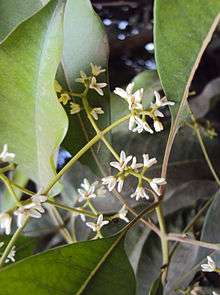Chionanthus ramiflorus
| Chionanthus ramiflorus | |
|---|---|
 | |
| Flowers and leaves | |
| Scientific classification | |
| Kingdom: | Plantae |
| (unranked): | Angiosperms |
| (unranked): | Eudicots |
| (unranked): | Asterids |
| Order: | Lamiales |
| Family: | Oleaceae |
| Genus: | Chionanthus |
| Species: | C. ramiflorus |
| Binomial name | |
| Chionanthus ramiflorus Roxb. | |
Chionanthus ramiflorus (syn. Linociera ramiflora (Roxb.) Wall.), commonly known as northern olive or native olive, is a species of shrubs and trees, of the flowering plant family Oleaceae. They grow naturally in India, Nepal, north eastern Australia (Queensland), New Guinea, the Philippines, southern China and Taiwan.[1][2][3]
They grow as evergreen shrubs or trees to 3–23 m (10–75 ft) tall. The leaves are 8–20 cm (3–8 in) long and 4–7 cm (1.6–2.8 in) broad, simple ovate to oblong-elliptic, with a 2–5 cm (0.8–2.0 in) petiole. The flowers are white or yellow, produced in panicles 2.5–12 cm (1.0–4.7 in) long. The fruit is a blue-black drupe 1.5–3 cm (0.6–1.2 in) long and 0.5–2.2 cm (0.2–0.9 in) diameter.[1][4]
Sometimes the species is treated in the segregate genus Linociera, though this does not differ from Chionanthus in any character other than leaf persistence, not a taxonomically significant character.[5]
References
- 1 2 Chang et al. (2008) Flora of China. Online "Chionanthus ramiflorus". Retrieved 26 June 2013.
- ↑ "Chionanthus ramiflorus Roxb.". Australian Plant Name Index (APNI), IBIS database. Centre for Plant Biodiversity Research, Australian Government. Retrieved 21 June 2013.
- ↑ World Conservation Monitoring Centre (1998). Linociera ramiflora
- ↑ Hyland, B. P. M.; Whiffin, T.; Zich, F. A.; et al. (Dec 2010). "Factsheet – Chionanthus ramiflorus". Australian Tropical Rainforest Plants. Edition 6.1, online version [RFK 6.1]. Cairns, Australia: Commonwealth Scientific and Industrial Research Organisation (CSIRO), through its Division of Plant Industry; the Centre for Australian National Biodiversity Research; the Australian Tropical Herbarium, James Cook University. Retrieved 26 June 2013.
- ↑ Chang et al. (2008) Flora of China. Online "Chionanthus". Retrieved 26 June 2013.
Cited works
- Chang, Mei-chen; Chiu, Lien-ching; Wei, Zhi; Green, Peter S. (2008) [1992]. Wu, Z. Y.; Raven, P. H., eds. "Oleaceae; Chionanthus ramiflorus". Flora of China. Online version (print version). eFloras.org. Beijing and St. Louis, MO: Science Press and Missouri Botanical Garden Press. Retrieved 26 June 2013.
